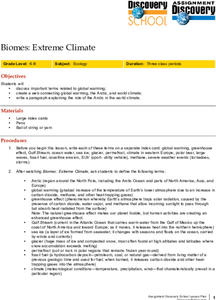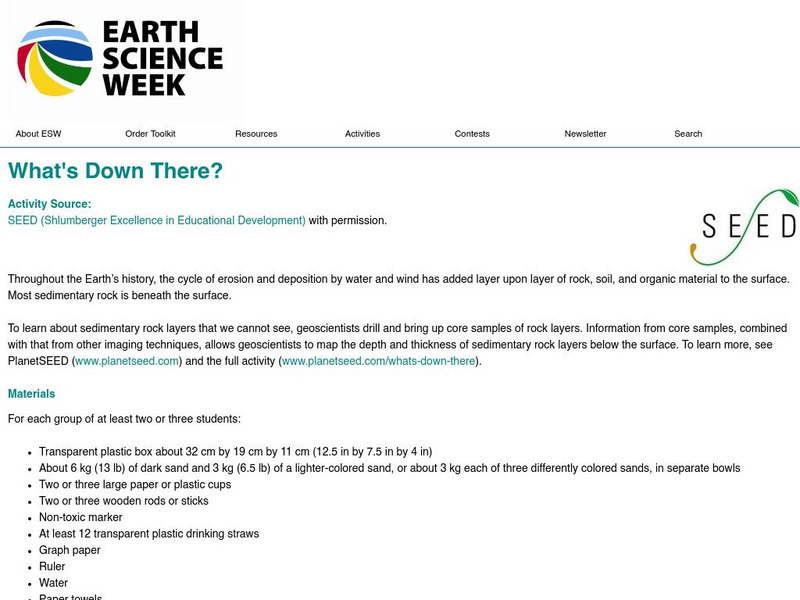Curated OER
Biomes: Extreme Climate
Students create a web connecting global warming, the Arctic, and wold climate. They write a paragraph explaining the role of the Arctic in world climate.
Curated OER
Segmented Worms
In this segmented worms instructional activity, high schoolers will review the characteristics of segmented worms including the earthworm, bristleworm, and leech. This instructional activity has 7 fill in the blank, 3 true or false, and...
Curated OER
Look At A Landfill
Students explore how landfills function. In this landfill activity, students explore the use of landfills and the decomposition process by creating a model landfill. Students discuss pros and cons to landfills and how potential...
Curated OER
Extreme Climate
Students discuss global warming, greenhouse effect, permafrost and other key words. In this climate lesson students create a web that connects global warming, the Arctic and world climate then write a paragraph explaining the role...
Curated OER
Mud Splat Craters
Students simulate crater formation using mud. For this earth science lesson, students identify the features of a crater. They explain how the force of impact affect the crater's appearance.
Curated OER
Underground Pollution
Fourth graders construct their own aquifer. They discover how water travels underwater and identifies sources of underground pollution. They record their observations and discuss the results.
Curated OER
Stratigraphy and Cross-Dating
Students interpret archaeological strata using the law of superposition. They apply cross-dating to determine the age of other artifacts.
Curated OER
Building the Terrarium
Students draw a layout of their proposed terrarium. In this social studies activity, students discuss how Mayans farm to produce food for the family. They compare their farming method with modern farming practices.
Curated OER
Garbage Can Archaeology
Students explore the use of stratigraphy to date objects by sorting the material in the wastebasket. They make a list of actual items from the garbage can and their possible uses and categorize the artifacts.
T
Curated OER
Bermuda Today: Who Were Its Geologic Ancestors?
Students explore how the island of Bermuda came to be.
Curated OER
Chronology: They Time of My Life
Students demonstrate the importance of intact information to achieve accuracy. They compare and constrast their timelines with the chronological information contained in a stratified archaeological site.
Curated OER
Water Quality
Students conduct experiments to study the quality of water. They examine how pollutants get into and affect the water supply in this unit.
Curated OER
Life in a Cup
Third graders make and maintain a mini terrarium. They keep a daily journal of what happens in their terrarium and record daily observations and measurements.
Curated OER
Ecology of the Dump
Students recreate landfills in petri dishes, observe relative biodegradability in a year-long project, and isolate a cellulose degrading bacteria while discovering the need for recycling and the serious problem waste management has...
Curated OER
Biomes: Extreme Climate
Middle schoolers discuss the causes of global warming. In this earth science lesson, students examine how global warming is connected to the arctic and world climate. They write a paragraph about their interconnection.
Utah Education Network
Uen: Nhmu: Our Ancient Earth the Stratigraphy Cup
Activity provides students an opportunity to make a stratigraphy cup.
Utah State Office of Education
Utah Science: Rocks, Minerals, and Soils Introduction
Dig into the layers of activities exploring and investigating minerals and how they are related to both rocks and soil.
Alabama Learning Exchange
Alex: Digging in for Dirt Day!
This activity is managed through stations that students will rotate around every 20- 30 minutes. Each second grade teacher conducts one station. Parent volunteers can also be used to manage stations. Students will use an auger to gather...
TeachEngineering
Teach Engineering: Shallow & Deep Foundations
Students investigate the critical nature of foundations as they learn differences between shallow and deep foundations, including the concepts of bearing pressure and settlement. Using models representing a shallow foundation and a deep...
American Geosciences Institute
American Geosciences Institute: Earth Science Week: What's Down There?
Students build a model to learn about the cycle of erosion and deposition by water and wind which deposits layer upon layer of rock, soil, and organic material to the surface.
Environmental Education for Kids
Eek!: Art and Crafts: Edible Aquifer
Groundwater is stored in and moves slowly through layers of soil, sand and rocks called aquifers. To help you visualize groundwater, you will make an aquifer, in this case, an edible one. This will show you how groundwater is stored and...



















